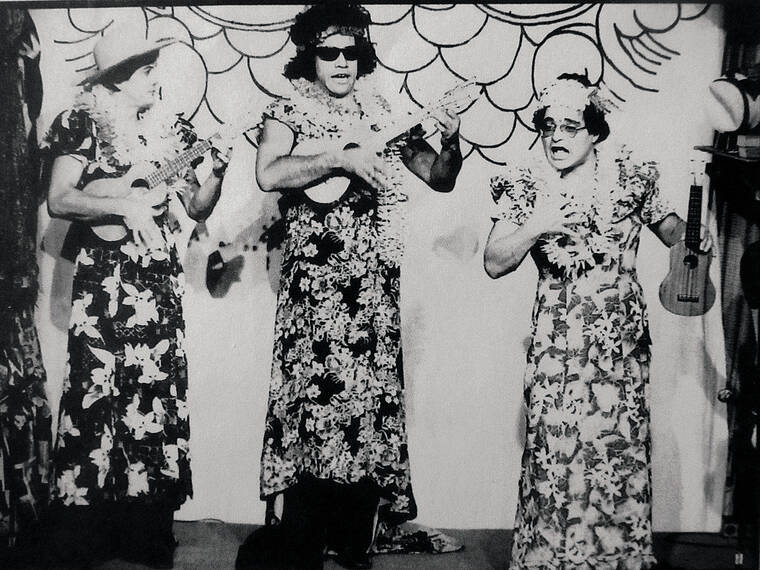Aiea backyard’s rainwater collection oasis provides inspiration for home gardeners
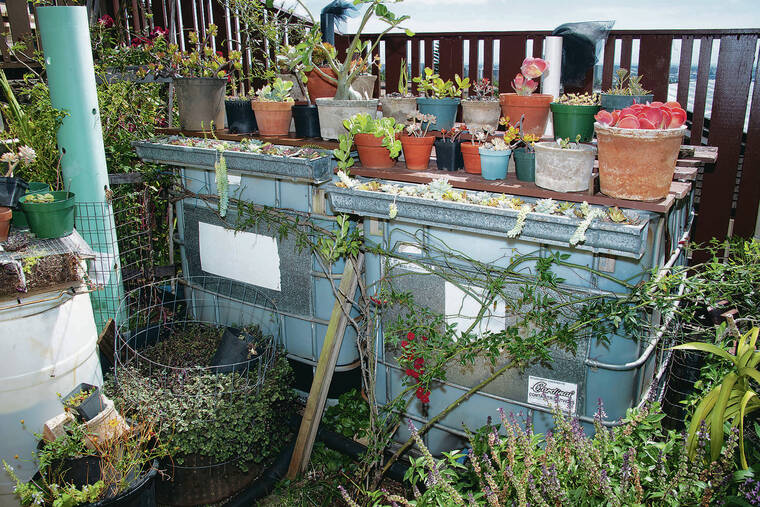
CRAIG T. KOJIMA / CKOJIMA@STARADVERTISER.COM
Amy Tsuneyoshi uses large water totes in her rainwater catchment system at her Aiea home. She also cultivates a variety of succulents and other plants that don’t require much water.
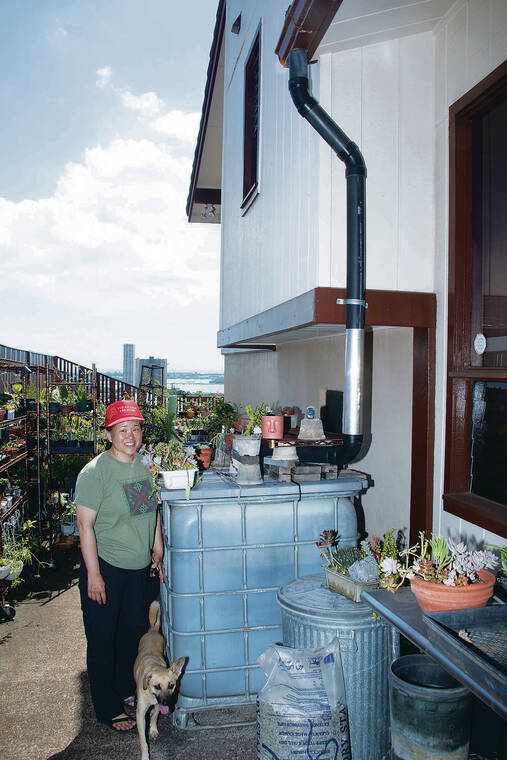
CRAIG T. KOJIMA / CKOJIMA@STARADVERTISER.COM
Amy Tsuneyoshi stands next to a tote water storage barrel, which is attached to a rain gutter at her home.
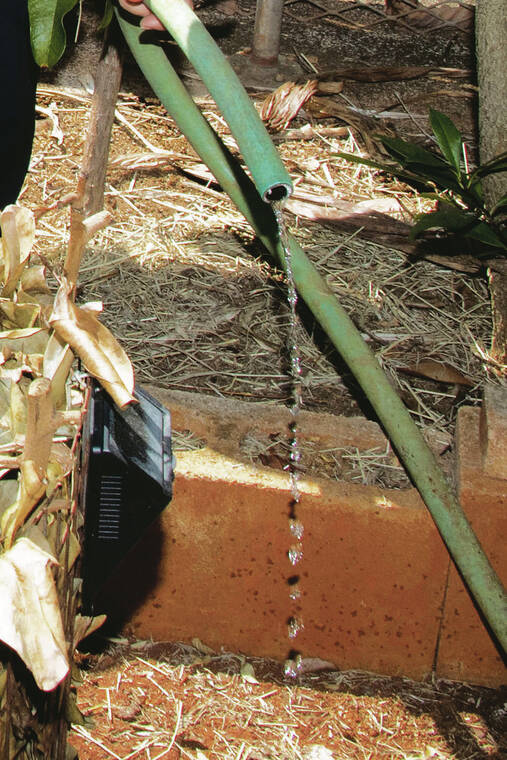
CRAIG T. KOJIMA / CKOJIMA@STARADVERTISER.COM
Water collected in the catchment system trickles out of a hose.
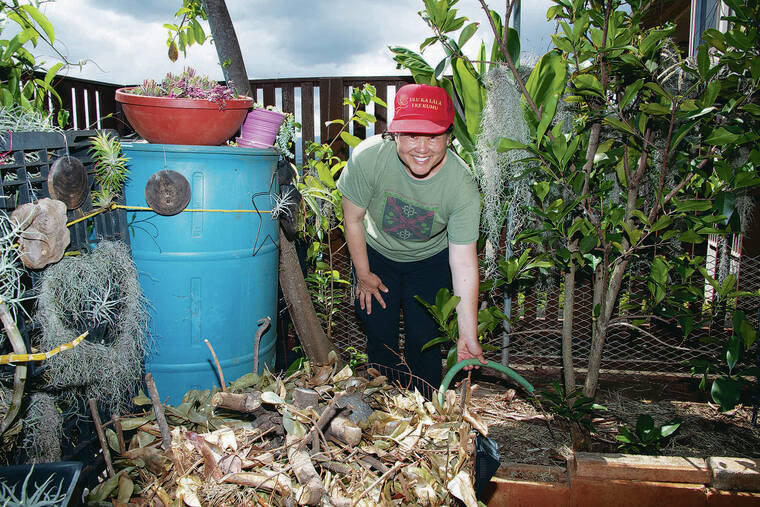
CRAIG T. KOJIMA / CKOJIMA@STARADVERTISER.COM
Amy Tsuneyoshi uses large water totes in her rainwater catchment system at her Aiea home. She also cultivates a variety of succulents and other plants that don’t require much water.




Amy Tsuneyoshi, a Board of Water Supply specialist for 25 years, takes her job home with her every day.
With a longtime personal interest in sustainable practices, she’s done a lot of homework on her own — collecting rainfall to irrigate her garden with a system fine-tuned over 20 years. As a water resource specialist, she works to protect the health of Hawaii’s forest watersheds to ensure that groundwater resources are recharged, and conservation is an integral part of the work.
“I just thought it was such a waste to see all the rainwater go down the storm drains and not being able to capture it,” said Tsuneyoshi.
Reducing the amount of rainwater that runs off the land can in turn help reduce pollution, water flow rates and erosion, water volumes and flooding, and it also recharges groundwaters, according to the city Department of Facility Maintenance’s website.
A few years after she began her rain catchment system at home, her supervisor asked her to take part in a city pilot project on developing a system. After years of improvements, she now has five large catchment containers around her yard to irrigate most of her plants without turning on the garden hose.
Tsuneyoshi’s concern for conservation is also reflected in her efforts as president of the nonprofit Friends of Halawa Xeriscape Garden, which encourages the use of drought-tolerant plants. The xeriscape garden is affiliated with the Board of Water Supply. She’s propagated hundreds of succulents and other varieties at her Aiea home, and supplies them for the group’s fundraisers.
Don't miss out on what's happening!
Stay in touch with breaking news, as it happens, conveniently in your email inbox. It's FREE!
Her fondness for succulents is rooted in their low maintenance, ease of propagation and their widely different types, colors and shapes. She’s recently branched out into carnivorous plants that capture insects for nutrition and found they thrive on rainwater, as they’re very sensitive to chemicals in the city water system.
Tsuneyoshi began collecting rainfall around 2000, simply putting buckets under the eaves of the roof, and gradually upgraded her catchment system over the years. Her next step was to set up a 55-gallon drum where the rain poured off the roof most heavily, but it filled up so quickly she added two more barrels.
She connected the three containers with a “daisy chain,” using a siphon (made from sections of a garden hose) to make the water flow from one barrel to the next on a slight slope, as the system relies on gravity. She also redirected the water to a fourth barrel some distance away in her garden.
Several years after she started her catchment system, Tsuneyoshi upgraded to larger “totes,” sturdy plastic containers reinforced with aluminum framing that cost about $100 each from Home Depot. The rectangular totes, normally used to contain industrial liquids, are 3- to 4-feet high and hold 275 to 375 gallons.
(The Board of Water Supply notes that one gallon of water weighs about 8 pounds; a 55-gallon barrel weighs over 400 pounds when full, so be sure to place any large container on a sturdy, level surface.)
About the same time, she had roof gutters and a downspout installed, and the largest tote was connected with a diverter to the downspout. This 375-gallon tote funnels rainwater through PVC piping to two other totes and two 55-gallon drums farther down in her yard. She found a diverter online but Hardware Hawaii also carries them. (A sticking point with some homeowners, however, is the concern over drilling into their downspout to install a diverter, Tsuneyoshi said.)
Her dad helped her install the PVC pipes, but she was able to drill the holes to connect the pipes to the barrels, using a drill bit and a “tap” to make pipe threads. She also installed ball valves on the bottom of the totes to turn the water on and off. For the average gardener who isn’t handy with tools and struggles with following online instructions, the Water Board and other agencies hold workshops on the procedure.
To water her plants, she attaches a hose with an on/off switch at the bottom of a barrel. This allows for the most water pressure from gravity, but it flows out slowly — the only drawback to her system. Tsuneyoshi is thinking about attaching a solar pump to her system — “I’m impatient,” she admits. In fact, in the past she’s left the water flowing from the hose to irrigate a patch of grass and forgotten to turn it off, which drained all the water out of the system.
Mosquitoes aren’t a problem because she places screens over the barrel openings, which keep them from breeding; the screens also keep out leaves and other items.
Overall, her plants are greener and get more water with rain catchment than if she only relied on the county system — “Now I don’t feel as bad using potable water,” she said.
—
COLLECTING AT HOME
The Board of Water Supply says that an inch of rain on a 1,000-square-foot rooftop yields 600 gallons of water. To calculate how much rainwater your rooftop will produce, multiply the square footage of your roof by 600 and divide by 1,000.
To make your own rain barrel, visit 808ne.ws/barrelconstruct; or go to the city Department of Facility Maintenance for instructions at 808ne.ws/containrain. At the latter website, homeowners also can sign up to be notified when future workshops are scheduled.
Is there a gardening topic you’d like to read about in the Garden Variety column? Email Pat Gee at pgee@ staradvertiser.com with your request.

